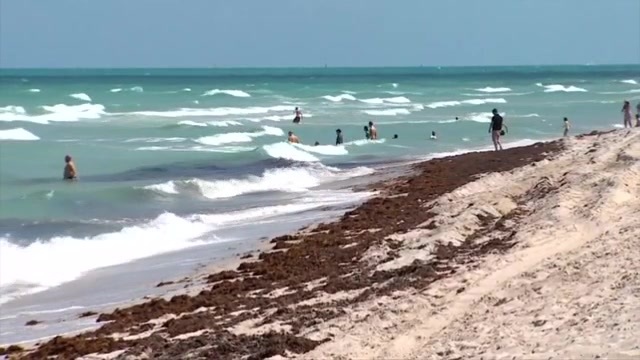The Influx of Sargassum Seaweed on South Florida Beaches
As beachgoers flock to the sun-soaked shores of South Florida, marine science experts are issuing warnings about the recent influx of sargassum seaweed washing ashore. This natural event, while common, has garnered attention due to its effects on beach conditions this weekend.
Recent Observations on Miami Beach
Reports from Miami Beach indicate a significant accumulation of the foul-smelling algae. Images captured on Friday revealed clusters of sargassum along the coastline, prompting varied reactions from visitors.
“The odor is overwhelming,” noted Juan Merulanda, emphasizing the discomfort the algae has brought to his beach experience. Meanwhile, beachgoer Edward Kapudo described the smell as “fishy, fishy, fishy,” reflecting a general consensus that the sargassum has made the beach less inviting.
Visitor Reactions and Experiences
Despite the presence of the seaweed, some visitors, like a young swimmer named Oliver, ventured into the water. “I didn’t really mind, but now it looks bad,” he remarked, showcasing a level of adaptability amid the conditions. His companion, Avery, shared her experience, pointing out the challenging waves and abundance of seaweed.
The Science Behind Sargassum
The proliferation of sargassum can impact the environment significantly. Dr. Brian Barnes, a marine science expert from the University of South Florida, warned that large accumulations could release harmful gases as they decompose, sometimes resulting in respiratory issues for sensitive individuals. “It’s like a rotten egg smell that’s not pleasant,” he stated.
The movement of sargassum is often caused by high-pressure systems that push it from the Sargasso Sea into the Caribbean, where the Gulf Stream carries it toward the Florida Straits, aided by strong winds.
Health Implications and Benefits
While no severe health risks are associated with the algae itself, medical professionals caution that small organisms living within the sargassum could cause skin irritations. However, the seaweed also plays a vital ecological role, serving as a habitat for various marine species, including turtles, and contributing nutrients to the beach ecosystem, particularly beneficial following storms.
Community Responses to Seaweed Accumulation
Visitors often express frustration about sargassum’s seasonal return. “I feel like it has gotten worse in the past few months,” one beachgoer noted. Many believe that while the phenomenon is a natural part of coastal life, municipalities should explore more effective removal strategies.
Local governments have implemented programs aimed at clearing sargassum from popular beach areas, aiming to enhance visitor experiences while acknowledging the environmental significance of the algae.
In conclusion, while the presence of sargassum creates challenges for beachgoers, its role in marine ecosystems cannot be overstated. Balancing human enjoyment with environmental stewardship remains an ongoing conversation in South Florida as communities navigate this natural occurrence.

